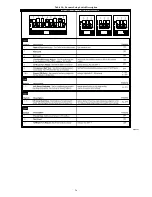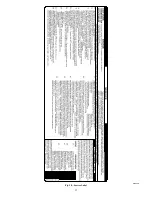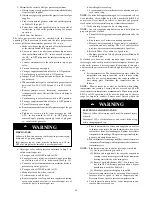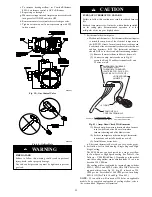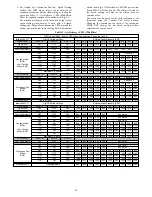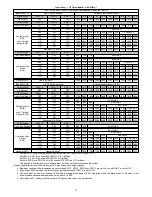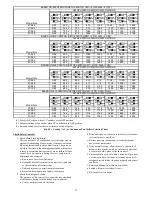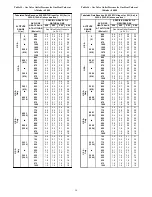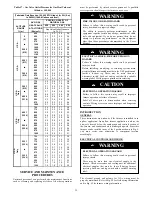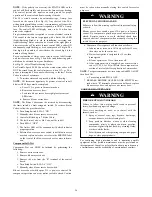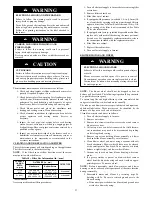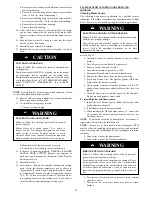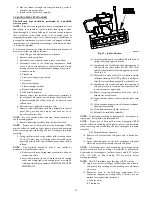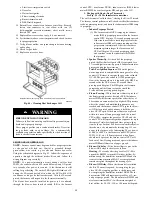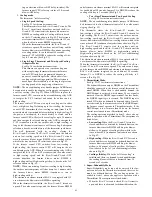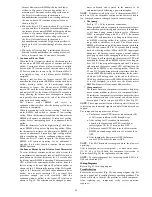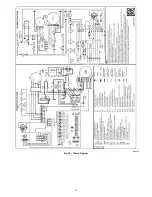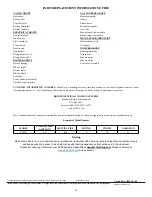
40
c. Limit over--temperature switch
d. Gas valve
e. Hot surface ignitor
f. Flame--sensing electrode
g. Burner thermal switch
h. DSS Draft Safeguard
14. Reinstall vent connector on furnace vent elbow. Securely
fasten vent connector to vent elbow with two (2)
field--supplied, corrosion--resistant, sheet metal screws
located 180
_
apart.
15. Replace blower access door only, if it was removed.
16. Set thermostat above room temperature and check furnace
for proper operation.
17. Verify blower airflow and speed changes between heating
and cooling.
18. Check for gas leaks.
19. Replace outer access door.
Representative drawing only, some models may vary in appearance.
A190291
Fig. 44 -- Cleaning Heat Exchanger Cell
FIRE OR EXPLOSION HAZARD
Failure to follow this warning could result in personal injury,
death and/or property damage.
Never purge a gas line into a combustion chamber. Never test
for gas leaks with an open flame. Use a commercially
available soap solution made specifically for the detection of
leaks to check all connections.
!
WARNING
SEQUENCE OF OPERATION
NOTE
: Furnace control must be grounded for proper operation
or else control will lock out. Control is grounded through
green/yellow wire routed to gas valve and burner box screw.
Using the schematic diagram in Fig. 45, follow the sequence of
operation through the different modes. Read and follow the
wiring diagram very carefully.
NOTE
: If a power interruption occurs during a call for heat
W/W1, the control will start a 90--second blower--only ON period
two seconds after power is restored, if the thermostat is still
calling for gas heating. The amber LED light will flash code 12
during the 90--second period, after which the LED will be ON
continuous, as long as no faults are detected. After the 90--second
period, the furnace will respond to the thermostat normally.
The blower door must be installed for power to be conducted
through the blower door interlock switch ILK to the furnace
control CPU, transformer TRAN, inducer motor IDM, blower
motor BLWM, hot--surface ignitor HSI, and gas valve GV.
1. Heating with Single--Stage Thermostat
See Fig. 25 -- 28 for thermostat connections
The wall thermostat “calls for heat”, closing the R--to--W circuit.
The furnace control performs a self--check, verifies the transducer
reads no pressure present, and starts the inducer motor IDM ramp
to prepurge.
a.
Inducer Prepurge Period
(1.) The furnace control CPU ramps up the inducer
motor IDM to prepurge pressure then the furnace
control CPU begins a 15--second prepurge period.
If the transducer fails to reach target pressure the
inducer motor IDM will remain running until tar-
get pressure is maintained. After the transducer
maintains pressure target, the furnace control
CPU will begin a 15--second prepurge period,
and continue to run the inducer motor IDM at
that pressure.
b.
Ignitor Warm--Up
--At the end of the prepurge
period, the Hot--Surface Ignitor HSI is energized for a
17--second ignitor warm--up period. Inducer maintains
pressure during ignitor warm--up.
Trial--For--Ignition Sequence
--When the ignitor
warm--up period is completed the main gas valve relay
contact GVR closes to energize the gas valve solenoid
GV--M. The gas valve solenoid GV--M permits gas
flow to the burners where it is ignited by the HSI. Five
seconds after the GVR closes, a 2--second flame
proving period begins. The HSI ignitor will remain
energized until the flame is sensed or until the
2--second flame proving period begins.
c.
Flame--Proving
-- When the burner flame is proved at
the flame--proving sensor electrode FSE, the inducer
motor IDM will increase speed (after a short delay of
14 seconds on some modes) to a higher RUN pressure
where the control will maintain this pressure once
reached, and the furnace control CPU begins the blow-
er--ON delay period and continues to hold the gas
valve GV--M open. If the burner flame is not proved
within two second flame proving period, the control
CPU will de--energize the gas valve GV--M, and the
control CPU will repeat the ignition sequence for up to
three more Trials--For--Ignition before going to Igni-
tion--Lockout. Lockout will be reset automatically after
three hours, or by momentarily interrupting 115 vac
power to the furnace, or by interrupting 24 vac power
at SEC1 or SEC2 to the furnace control CPU (not at
W/W1, G, R, etc.). If flame is proved when flame
should not be present, the furnace control CPU will
lock out of Gas--Heating mode and operate the inducer
motor IDM until flame is no longer proved.
d.
Blower--On delay
-- If the burner flame is proven the
blower--ON delays for heat are as follows:
Heating
-- 25 seconds after the gas valve GV--M is
opened the BLWM is turned ON at heat airflow. Si-
multaneously, the humidifier terminal HUM and elec-
tronic air cleaner terminal EAC--1 are energized and
remain energized throughout the heating cycle.
e.
Blower--Off Delay
--When the thermostat is satisfied,
the R to W circuit is opened, de--energizing the gas
valve GV--M, stopping gas flow to the burners, and
de--energizing the humidifier terminal HUM. The in-
ducer motor IDM will remain energized for a 15--sec-
ond post--purge period. The blower motor BLWM and
air cleaner terminal EAC--1 will remain energized at
heat airflow for 90, 120, 150, or 180 seconds (depend-
Содержание 830CA
Страница 22: ...22 A180242 Fig 31 Chimney Inspection Chart...
Страница 26: ...26 Table 10 Furnace Setup Switch Description A190351...
Страница 27: ...27 A190348 Fig 38 Service Label...
Страница 43: ...43 A190249 Fig 45 Wiring Diagram...

